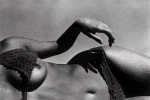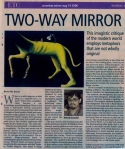You do not review Ralph Gibson but let him let you into his view and re spect. The word itself means re-view, to re-examine.
If you have the good fortune to meet Ralph Gibson you will know immediately that you are meeting a creative mind, an arrogant, intellectual man and you will come back entertained and enlightened. Here is Ralph Gibson on Ralph Gibson.
‘Context is everything, take the Venus de Milo, a beautiful nude, but if I were to say, there is still no cure for cancer, you would look at it differently.’
‘A missionary threw head shots of himself before he landed on an island, he then landed and the tribe promptly ate him. Either they thought he was throwing them the menu or they had difficulty reading the photograph. I’m interested in how different cultures see.’
‘I went to Egypt, I went up the Nile one man and came down the Nile another.’
…. man …. woman, rest room symbols, and it is replicated again and again on the dummies in the show room. That forms recur is no mistake. A culture is a sum total of its shapes. Photographers have to see shapes. I believe that there is a primal set of shapes, organic shapes are continuous, shapes of people, leaves, a smile considerably extend our boundaries, penetrate as an atom, go deep down to come up with a homunculus. We are seeing human, am I seeing English?’
Ralph Gibson loves books and his latest called Ex Libris, is a book about books. He visited several Libraries, saw the Polyglot Bible in Hebrew, Latin and Greek. His fascination for words and what they mean and what feelings they evoke is only secondary to the way they look. Typography is the pre cursor of photography and its use is tactical. The filigree of Gothic and the rectangularity of Hebrew is for him a ‘departure point’. He is fascinated with shapes. He would do the diptych put two images together, a hand holding a gun, and a woman at the side of another picture, he called the picture the Perfect Future.









Much of the book Ex Libris is about placement of two images that are unrelated which when put alongside seem to carry on a spirited argument sometimes or a resplendent laidback smoke. The images themselves form part of the Generative System Theory where to start with there may be a painting, then a poster of the painting and then a photograph of the poster of the painting, each time the meaning changes.
He likes the idea of being incredibly arbitrary of where to put the focus, out of focus, or in focus, just to see where it will take him. On the other hand it would seem contrary that he will stick with one lens and shoot everything at a 3 foot distance till he has understood the language of that particular lens. If he signs a print he takes total responsibility for everything. No happy accidents in the background, he takes all the credit or all the blame. His morality is entirely reflected in his work, not in the amount of money he puts in the ‘poor box’ in church.
He decided early on that his life-time tool would be a Leica and he goes on to say that more great photographs have been made with a Leica and a 50mm lens than any other camera. He says that camera handling is crucial to the process, that it should be second nature and that if you shoot 10 rolls a day for the next 4 months you will automatically become a better photographer. He practices to stay warmed up, just moves film through his camera and if he doesn’t he fears he may lose his camera handling skills.
In his book Ich Bin Nacht (I am the Night) he worked by night in Berlin where he believes the night begins. He still functions as a street photographer after having dropped out of Magnum where he started out as a reporter, except now he does not want to report anything. He feels no great compunction to portray the whole Brandenburg gate, the bridge where they exchanged spies, the night is just a point of departure, it abstracts things and gets rid of a lot of information and it is a higher form of information.


‘I studied photography, learnt it, then serving it you become Photography, can you deny that Cartier Bresson is not photography? The photograph is always more intelligent than the photographer. The medium is always larger. We realise that the photographer is not the photograph, nor the radio, music. The photographer speaks through the photograph.’
His mission is that nothing comes between him and his work, he thought it was a sacrifice, to give up on time with the family, now he thinks to have done anything else would have been a sacrifice.
There are lots of reasons for making a photograph. Take a nude, you can work on minimal flatness, or as erotica, or to experience tonality, or to explore north window light in your studio, it is just an excuse to know more about photography. He says I want to make a Photography, all my points of departure make a sub text. His father is a diplomat his mother an eccentric who thought all her relatives were on the walls of Pompeii. He wants to look as far back as he can as a contemporary living today. Jews carry that around in them, they are Antiquity.
‘When I make a book, I show how I think about my work and photographs, no one will know more about my work than I. Photographs are objects that lie suspended between the present and the past. Mao brought the watch to China and forced it to measure Time, better than burning candles. Photographers have gone one better in ending time.’ A book publisher wanted to cut one of his images in half for the cover. “We will double your money” they said, when he objected. “Ok double it” I said, otherwise it will be bad for my work, but no cutting the image in half. That is staying pure, I am not going to cut my nose to spite my face’.
‘How you feel is how you determine reality, the only thing real is how you feel’ ‘So long as you want to say something, photography will be around to record it’
Even if you are not a photographer you get the goose bumps listening to Ralph Gibson, there is an insouciance, a take it or leave it style, a panache for articulation and you are touched by the wisdom.
